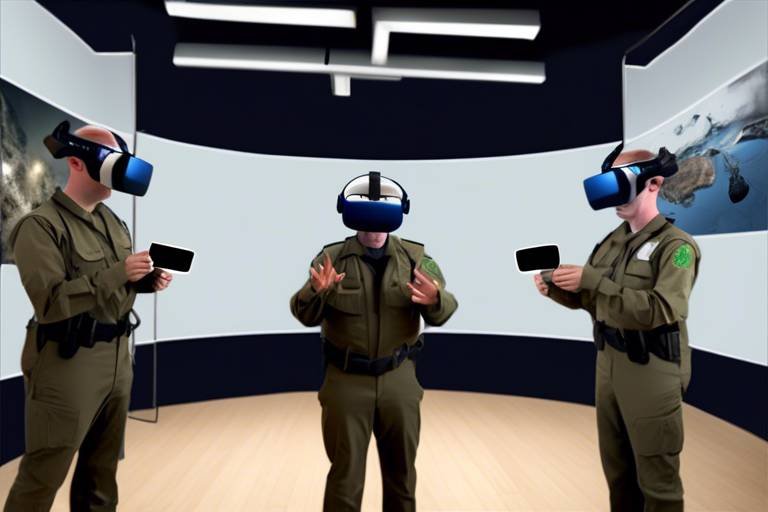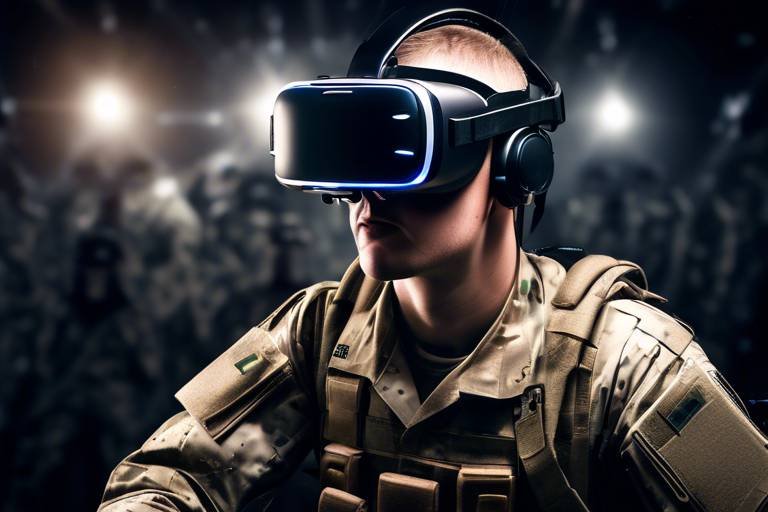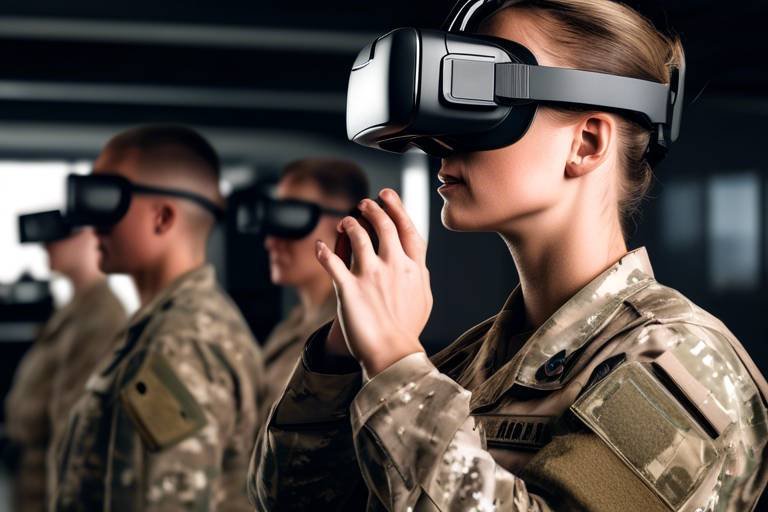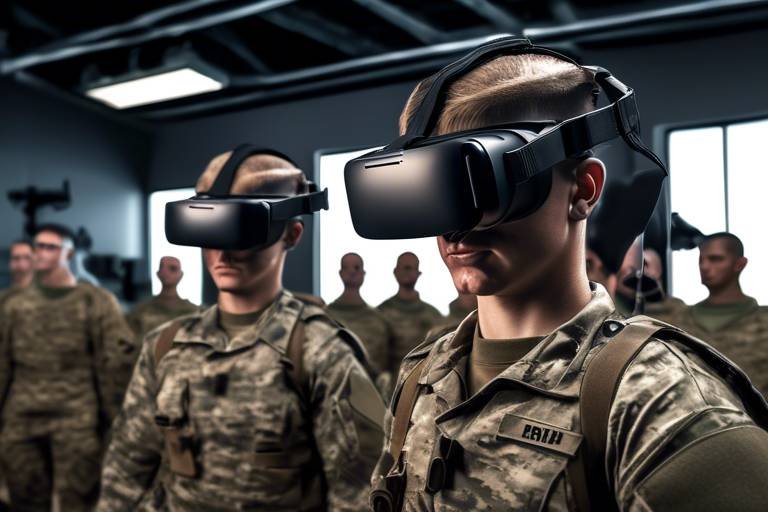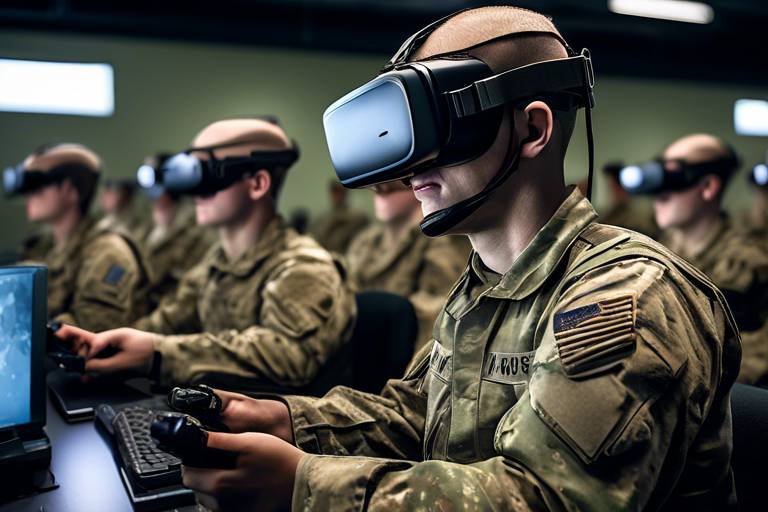How VR Technology Enhances Live-Simulation Training
In today's fast-paced world, the need for effective training methods has never been greater. Enter Virtual Reality (VR), a technology that is not just a buzzword but a revolutionary tool transforming how we approach live-simulation training. Imagine being able to step into a lifelike environment where you can practice skills, make mistakes, and learn without the real-world risks. Yes, that's the power of VR! This article delves into how VR enhances live-simulation training across various industries, showcasing its benefits, applications, and future potential.
So, what exactly is VR technology? At its core, VR creates a simulated environment that can be similar to or completely different from the real world. Using headsets, motion sensors, and interactive software, users are transported into immersive experiences that engage their senses. Think of it as a portal where you can practice a surgical procedure, fly a plane, or even engage in combat without ever leaving the room. This technology leverages the brain's ability to adapt and learn from experiences, making it a powerful tool for training.
Why should organizations consider incorporating VR into their training programs? The advantages are compelling:
- Increased Engagement: VR captivates users, keeping them focused and involved in their training. With traditional methods, attention can wane, but VR creates an experience that feels real and urgent.
- Improved Retention: Studies show that immersive learning leads to better retention of information. When learners are actively participating in a scenario, they are more likely to remember what they learned.
- Safe Simulation of Real-World Scenarios: VR allows for the safe practice of high-stakes situations. Learners can make mistakes without any real-world consequences, fostering a deeper understanding of their tasks.
One of the standout features of VR technology is its ability to foster deep engagement during training sessions. When users don the VR headset, they are no longer passive observers; they become active participants in their learning journey. This level of engagement is crucial for effective skill acquisition. Just like how a child learns to ride a bike by actually getting on one, VR allows trainees to practice skills in an environment that mimics reality. The result? Better learning outcomes and a more profound grasp of the material.
Imagine practicing a complex surgery in a virtual operating room, complete with realistic instruments and patient responses. This is what immersive learning experiences in VR offer. They provide learners with the opportunity to practice skills in realistic settings, making the training experience not just relevant but also impactful. The sense of presence in the VR environment can lead to a higher level of confidence when transitioning to real-world applications.
One of the most significant advantages of VR systems is their capacity to provide immediate feedback. Picture this: you’re practicing a firefighting technique in a VR simulation, and as soon as you make a mistake, the system alerts you, offering guidance on how to correct it. This real-time feedback loop helps learners adjust their actions on the spot, significantly improving their performance and understanding of the task.
Implementing VR training programs can also lead to substantial cost savings. Traditional training methods often involve expenses related to travel, equipment, and facilities. In contrast, VR training can be conducted in a controlled environment without the need for physical resources. Organizations can allocate their budgets more efficiently, allowing for investment in other critical areas.
VR technology is making waves across multiple sectors, showcasing its versatility and effectiveness in training. Here are some notable applications:
In the healthcare sector, VR simulations allow medical professionals to practice procedures in a risk-free environment. Imagine a surgeon honing their skills on a virtual patient before ever stepping into an operating room. This not only enhances their skills but also builds confidence, ensuring they are well-prepared for real-life scenarios.
The military utilizes VR for tactical training, enabling soldiers to experience combat scenarios without the dangers associated with live exercises. These simulations can replicate various environments and situations, allowing soldiers to train effectively and safely. It’s like preparing for a big game by running through every possible play without ever stepping onto the field.
As technology advances, the future of VR training looks incredibly promising. Innovations are on the horizon that will further enhance the learning experience and broaden its applications across industries.
Combining VR with artificial intelligence will create personalized training experiences that adapt to individual learning styles and progress. Imagine a training program that learns from your mistakes and adjusts the difficulty level accordingly, providing tailored challenges that keep you engaged and progressing at your own pace.
Future developments in VR technology aim to make training more accessible. This means that individuals from diverse backgrounds and with varying levels of experience can benefit from immersive learning experiences. Just like the internet opened up a world of information, VR has the potential to democratize training, ensuring that everyone has the opportunity to learn and grow.
Q: What industries are currently using VR for training?
A: Industries such as healthcare, military, aviation, and corporate training are leveraging VR technology to enhance their training programs.
Q: How does VR improve learning retention?
A: VR creates immersive experiences that engage learners actively, leading to better retention of information compared to traditional training methods.
Q: Is VR training cost-effective?
A: Yes! VR training can reduce costs associated with traditional training methods, such as travel and equipment expenses.

Understanding VR Technology
Virtual Reality (VR) technology represents a fascinating intersection of innovation and human experience. At its core, VR is designed to immerse users in a completely digital environment, allowing them to interact with a simulated world as if they were physically present. This technology relies on several key components that work together to create a seamless experience:
- Head-Mounted Displays (HMDs): These are the most recognizable part of VR systems. HMDs cover the eyes and display a stereoscopic image that tricks the brain into perceiving depth, making the virtual world feel real.
- Motion Tracking Sensors: These sensors track the user's movements, allowing them to look around and interact with the environment. This tracking can be done through external cameras or built-in sensors in the HMD.
- Controllers: Handheld devices that allow users to manipulate objects within the VR space. These controllers often come equipped with buttons, triggers, and motion sensors for a more interactive experience.
- Sound Systems: 3D audio plays a crucial role in VR, providing realistic soundscapes that enhance immersion by mimicking how sound behaves in the real world.
When combined, these elements create an immersive experience that can significantly enhance learning and training outcomes across various fields. Imagine stepping into a virtual operating room, where a medical trainee can practice complex surgical procedures without any risk to patients. Or consider a soldier training in a virtual battlefield, where they can learn tactical maneuvers without the dangers associated with live-fire exercises. These scenarios highlight just how powerful VR can be in simulating real-world situations.
Moreover, the technology behind VR is constantly evolving. Recent advancements include improved graphics rendering, more responsive motion tracking, and the integration of artificial intelligence, which can tailor experiences to the user’s skill level and learning pace. This evolution not only enhances the realism of the simulations but also broadens the scope of applications for VR technology, making it a versatile tool for various industries.
As we explore the transformative impact of VR technology on live-simulation training, it’s essential to remember that the goal is not just to create a captivating experience but to facilitate effective learning. By immersing users in realistic scenarios, VR can help bridge the gap between theory and practice, making it an invaluable asset in today’s training environments.

Benefits of VR in Training
The integration of Virtual Reality (VR) technology into training programs is nothing short of revolutionary. Imagine stepping into a world where you can practice high-stakes skills without any real-world consequences. That’s the magic of VR! This technology offers a plethora of benefits that can significantly enhance the learning experience across various fields. From healthcare to corporate environments, the advantages are both compelling and transformative.
One of the most notable benefits of VR in training is the increased engagement it fosters. Traditional training methods can often feel monotonous, leaving participants disengaged and uninspired. In contrast, VR captivates users by immersing them in interactive environments that stimulate their senses and hold their attention. When learners are genuinely engaged, they are more likely to absorb information and retain it long-term. Studies have shown that immersive learning experiences can lead to retention rates of up to 75%, compared to just 10% to 20% with traditional methods.
Engagement is at the heart of effective learning. With VR, learners are not just passive recipients of information; they are active participants in their training journey. Picture this: instead of sitting in a classroom, you’re navigating a virtual hospital, diagnosing patients, or flying a plane through a storm. This hands-on approach not only makes learning enjoyable but also reinforces the material in a way that traditional lectures simply cannot. The immersive nature of VR creates a sense of presence, making learners feel as if they are truly part of the experience. This heightened involvement can lead to deeper understanding and mastery of complex skills.
Immersive environments created by VR allow learners to practice skills in realistic settings, making the training experience more relevant and impactful. For instance, in a VR simulation for emergency response training, participants can face various scenarios that challenge their problem-solving skills and decision-making abilities. This type of experiential learning not only prepares them for real-life situations but also boosts their confidence in applying what they’ve learned. The ability to repeat scenarios until mastery is achieved further solidifies the learning process.
Another significant advantage of VR training is the provision of real-time feedback. Unlike traditional training methods where feedback might come days or weeks later, VR systems can analyze performance on the spot. Imagine a medical trainee performing a surgical procedure in a virtual environment; they can receive instant corrections on their technique, ensuring they learn the right skills from the get-go. This immediate response allows for quicker adjustments, leading to improved performance and skill acquisition.
Implementing VR training programs can also prove to be cost-effective. Traditional training methods often involve travel expenses, equipment costs, and facility rentals, which can add up quickly. With VR, organizations can create simulations that can be used repeatedly without incurring additional costs. For example, a company can invest in a single VR training module that can train hundreds of employees over time. This not only saves money but also allows for consistent training experiences across the board.
In conclusion, the benefits of using VR in training are vast and varied. From enhancing engagement and retention to providing real-time feedback and cost savings, this technology is reshaping the landscape of learning. As we continue to explore its potential, the future of training looks brighter than ever!
- What industries can benefit from VR training? VR training is applicable in various sectors, including healthcare, military, aviation, corporate training, and even education.
- Is VR training expensive to implement? While there is an initial investment, VR training can be cost-effective in the long run due to reduced travel and equipment costs.
- Can VR training be customized for different learning styles? Yes! VR training can be tailored to meet the needs of different learners, enhancing the overall training experience.

Enhanced Engagement
When it comes to training, engagement is the name of the game. Have you ever sat through a dull presentation, fighting the urge to check your phone? It’s a struggle we all know too well. But with virtual reality (VR), that experience transforms dramatically. Imagine stepping into a vibrant, interactive world where you’re not just a passive observer but an active participant. This is where VR shines, captivating users and fostering deep engagement during training sessions. It’s like swapping out a flat, boring textbook for an exhilarating adventure that pulls you in and keeps you on your toes.
One of the most compelling aspects of VR is its ability to create immersive learning experiences. Instead of merely reading about a concept or watching a video, learners can practice skills in realistic settings that mimic real-world scenarios. For instance, a medical student can perform a virtual surgery, feeling the pressure of the operating room without any real-life consequences. This hands-on approach not only makes the training more relevant but also significantly enhances knowledge retention. Studies have shown that people remember information better when they actively engage with it, and VR takes that to a whole new level.
Furthermore, VR systems can provide real-time feedback. Picture this: you’re in a virtual environment, practicing a complex procedure or skill. As you go through the motions, the system tracks your performance and offers immediate suggestions for improvement. This instant feedback loop allows you to correct mistakes on the spot, reinforcing learning and boosting your confidence. It’s like having a personal coach right there with you, guiding you through every step until you master the skill.
In addition to enhancing engagement, VR training can also cater to various learning styles. Some people are visual learners, while others might grasp concepts better through auditory means or hands-on practice. VR can integrate different modalities, allowing users to interact with the material in a way that suits them best. This tailored approach not only keeps learners engaged but also ensures that everyone gets the most out of their training experience.
Ultimately, the engagement factor in VR training is a game-changer. It transforms mundane learning into an exciting adventure, making the process enjoyable and effective. As more organizations embrace this technology, the potential for improved training outcomes becomes limitless. So, if you’re looking to boost engagement and make learning stick, VR might just be the perfect solution!
- What industries are using VR for training? VR is being utilized in healthcare, military, aviation, corporate training, and more.
- How does VR improve learning retention? By providing immersive, hands-on experiences that engage users actively, VR enhances memory retention.
- Can VR training be customized? Yes, VR training programs can be tailored to meet individual learning styles and needs.

Immersive Learning Experiences
When we think about traditional training methods, they often involve textbooks, lectures, and perhaps a few hands-on activities. But through VR technology take training to a whole new level. Imagine stepping into a virtual world where you can practice your skills in real-time, surrounded by lifelike simulations that mimic actual scenarios. This is the magic of VR! It creates a safe space where learners can make mistakes, experiment, and truly grasp complex concepts without the fear of real-world consequences.
One of the most fascinating aspects of immersive learning is how it engages all your senses. In a VR environment, you’re not just a passive observer; you’re an active participant. Whether you’re performing surgery in a virtual operating room or piloting a plane, the sensory feedback makes the experience feel incredibly real. This heightened sense of realism can enhance memory retention significantly. Studies have shown that when learners are fully immersed, they are more likely to remember information and skills long after the training session has ended.
Furthermore, VR allows for a level of repetition that traditional training simply cannot match. For instance, a medical student can practice a surgical procedure repeatedly until they feel confident, without the need for a real patient. This kind of practice leads to a deeper understanding and mastery of the skills required. The ability to simulate various scenarios, from emergency responses to complex machinery operations, means that learners can encounter a wide range of situations and challenges. This exposure prepares them for the unpredictability of real-life situations.
Additionally, the collaborative nature of VR can foster teamwork and communication skills. In many VR training programs, multiple users can interact in the same virtual space, allowing them to work together to solve problems or complete tasks. This not only enhances their individual skills but also builds camaraderie and teamwork among participants. Imagine a group of firefighters conducting a simulated rescue operation in a virtual environment, where they must communicate effectively to save lives. This kind of immersive training can be invaluable in high-stakes professions.
To summarize, immersive learning experiences powered by VR technology are revolutionizing the way we approach training. They provide a safe, engaging, and effective way for learners to practice and hone their skills in a realistic setting. As we continue to explore the potential of VR in education and training, the possibilities for enhancing learning outcomes are truly exciting!
- What is immersive learning? Immersive learning involves engaging learners in a realistic and interactive environment, often using technology like VR to enhance the experience.
- How does VR improve training outcomes? VR improves training outcomes by providing realistic scenarios, enabling repetition, and offering immediate feedback, which enhances skill retention and confidence.
- Can VR training be applied in all industries? Yes, VR training can be applied across various industries, including healthcare, military, aviation, and corporate training, making it a versatile tool for skill development.
- Is VR training cost-effective? While initial setup costs can be high, VR training can ultimately reduce expenses related to travel, equipment, and facility usage in traditional training methods.

Real-Time Feedback
This article explores the transformative impact of virtual reality (VR) technology on live-simulation training, showcasing its benefits, applications, and future potential in various industries.
Virtual reality (VR) technology is a groundbreaking advancement that immerses users in a computer-generated environment, allowing them to interact with 3D worlds as if they were real. This technology comprises several key components, including head-mounted displays (HMDs), motion tracking sensors, and haptic feedback devices. Together, these elements create a compelling and interactive experience that enhances learning and training outcomes across various fields.
Exploring the key advantages of using VR for training purposes reveals a treasure trove of benefits. From increased engagement to improved retention, VR offers a unique ability to simulate real-world scenarios safely. As we dive deeper, we’ll uncover how these benefits translate into real-world applications.
VR technology captivates users, fostering deep engagement during training sessions. Imagine stepping into a virtual world where you can practice your skills in a dynamic environment that feels incredibly real. This level of immersion leads to better learning outcomes and skill acquisition. When learners are fully engaged, they are more likely to absorb information and apply it effectively in real-life situations.
The immersive environments created by VR allow learners to practice skills in realistic settings, making the training experience more relevant and impactful. For instance, a medical student can perform surgery in a virtual operating room, honing their skills without the risk of harming a patient. This kind of experiential learning is not only effective but also enjoyable, making it easier for learners to retain information.
One of the most powerful features of VR training is the ability to provide to users. Imagine you’re in a virtual training session, and as you navigate through a complex scenario, the system analyzes your actions and offers immediate insights. This instantaneous feedback loop is crucial for several reasons:
- Immediate Correction: Users can identify and correct mistakes on the spot, leading to faster skill development.
- Enhanced Learning: By receiving feedback while performing tasks, learners can adjust their approach and improve their performance in real-time.
- Confidence Building: Real-time feedback fosters a sense of accomplishment and confidence as users see their progress unfold before them.
For example, in a VR flight simulator, a trainee pilot might receive alerts about their altitude or speed, allowing them to make quick adjustments. This kind of immediate response is invaluable, as it mirrors the fast-paced nature of real-world scenarios where decisions must be made swiftly and accurately.
Implementing VR training programs can reduce costs associated with traditional training methods, such as travel, equipment, and facility expenses. Companies can save significant amounts by utilizing virtual environments instead of physical ones.
VR technology is being utilized across multiple sectors, including healthcare, military, aviation, and corporate training, demonstrating its versatility and effectiveness.
In healthcare, VR simulations allow medical professionals to practice procedures in a risk-free environment, enhancing their skills and confidence before working with real patients.
The military employs VR for tactical training, enabling soldiers to experience combat scenarios without the dangers associated with live exercises.
As technology advances, the future of VR training looks promising, with innovations that will further enhance the learning experience and broaden its applications.
Combining VR with artificial intelligence will create personalized training experiences that adapt to individual learning styles and progress.
Future developments in VR technology aim to make training more accessible, allowing individuals from diverse backgrounds to benefit from immersive learning experiences.
- What industries benefit most from VR training? VR training is particularly beneficial in healthcare, military, aviation, and corporate sectors.
- How does VR provide real-time feedback? VR systems analyze user actions during training and offer immediate insights for improvement.
- Is VR training cost-effective? Yes, VR training can significantly reduce costs related to traditional training methods.
- Can VR training be customized for individual learners? Absolutely! Future trends include integrating AI to tailor experiences to individual learning styles.

Cost-Effectiveness
When it comes to training, one of the most critical factors organizations consider is . Traditional training methods often involve significant expenses, ranging from travel costs to hiring specialized instructors. However, VR technology is revolutionizing this landscape by offering a more affordable and efficient alternative. Imagine being able to conduct complex training sessions without the need for expensive equipment or travel arrangements—this is precisely what VR brings to the table.
By utilizing VR, companies can significantly cut down on costs associated with physical training environments. For instance, consider a scenario where a business needs to train employees on safety procedures. Instead of renting out a venue or purchasing physical equipment, they can create a virtual environment where employees can practice and hone their skills without any associated risks or costs. This not only saves money but also allows for the training to be conducted at any time, eliminating scheduling conflicts.
Moreover, the scalability of VR training programs is another aspect that enhances their cost-effectiveness. Once a VR training module is developed, it can be used repeatedly without incurring additional costs. This is a stark contrast to traditional training methods, where each session might require new materials, resources, and personnel. By investing in VR technology, organizations can create a sustainable training model that maximizes their return on investment.
| Traditional Training Costs | VR Training Costs |
|---|---|
| Venue Rental | No venue costs |
| Travel Expenses | No travel needed |
| Instructor Fees | One-time development cost |
| Material and Equipment | Minimal ongoing costs |
Additionally, VR training can lead to fewer errors in real-world applications. By allowing trainees to practice in a safe environment, organizations can ensure that their employees are better prepared for actual scenarios. This preparedness can lead to reduced costs related to accidents and mistakes that might occur during traditional training methods. In essence, investing in VR training not only saves money upfront but also prevents costly errors down the line.
In conclusion, the of VR technology in training is a game-changer for many industries. It allows for high-quality training experiences at a fraction of the cost associated with traditional methods. As organizations continue to embrace this technology, the potential for savings and improved training outcomes is enormous, making VR an increasingly attractive option for businesses looking to invest in their workforce.
- What is VR training? VR training uses virtual reality technology to create immersive learning experiences that simulate real-world scenarios.
- How does VR training save costs? VR training eliminates the need for physical venues, travel expenses, and ongoing instructor fees, making it a more affordable option.
- Can VR training be customized? Yes, VR training modules can be tailored to meet the specific needs and learning styles of an organization.
- Is VR training effective? Numerous studies show that VR training enhances engagement, retention, and skill acquisition, leading to better training outcomes.

Applications in Various Industries
Virtual Reality (VR) technology is not just a buzzword; it's a game changer across various sectors. From healthcare to military training, the applications of VR are as diverse as they are impactful. Imagine a world where professionals can hone their skills in a safe, controlled environment, free from the risks associated with real-life scenarios. That's the promise of VR!
In the healthcare industry, VR simulations are revolutionizing the way medical professionals train. Surgeons can practice intricate procedures on virtual patients, allowing them to make mistakes and learn from them without any real-world consequences. This not only enhances their skills but also builds their confidence before they ever touch a real patient. For instance, a study showed that surgeons who trained with VR simulations performed 30% better than those who relied on traditional methods.
The military sector has also embraced VR technology with open arms. Soldiers can engage in tactical training exercises that replicate real combat scenarios without the associated dangers. This immersive experience prepares them for the unpredictability of real-world situations, allowing them to react effectively under pressure. The ability to simulate various environments—from urban warfare to desert operations—ensures that troops are well-prepared for any mission they might face.
In the aviation industry, pilots are using VR for flight simulations that are incredibly close to reality. This technology allows aspiring pilots to experience the cockpit environment, practice emergency procedures, and navigate various flight conditions without ever leaving the ground. The cost savings here are significant, as training hours in actual aircraft can be exponentially more expensive than using VR simulators.
Corporate training is another area where VR is making waves. Companies are utilizing virtual environments to onboard new employees, provide safety training, and even enhance team-building exercises. By immersing employees in realistic scenarios, organizations can ensure that their staff is better prepared for the challenges they will face in the workplace. For example, a VR training program for customer service representatives can simulate difficult customer interactions, allowing employees to practice their responses in a safe space.
As we delve deeper into the applications of VR across these industries, it's clear that the technology is not merely a novelty; it’s a vital tool for effective training and skill development. Each sector is finding unique ways to incorporate VR into their training regimens, and the results speak for themselves. The ability to practice in a risk-free environment, receive instant feedback, and experience realistic scenarios is invaluable.
In conclusion, the versatility of VR technology is paving the way for enhanced training across multiple domains. Whether in healthcare, military, aviation, or corporate settings, the benefits of immersive training are undeniable. As VR continues to evolve, we can only imagine the new possibilities it will unlock for professionals in every field.
- What industries benefit the most from VR training?
Industries such as healthcare, military, aviation, and corporate training are seeing significant benefits from VR technology. - How does VR improve learning outcomes?
VR enhances learning by providing immersive experiences that engage users, allowing for better retention and skill acquisition. - Is VR training cost-effective?
Yes, VR training can reduce costs associated with traditional training methods, including travel and equipment expenses. - Can VR training be personalized?
With advancements in technology, VR training can be tailored to individual learning styles and progress, especially when integrated with AI.

Healthcare Training
In the ever-evolving field of healthcare, the need for effective training methods is paramount. Virtual Reality (VR) has emerged as a game-changer, transforming the way medical professionals acquire and refine their skills. Imagine being able to step into a fully immersive simulation where you can practice complex surgical procedures without the fear of making a mistake that could harm a patient. This is not just a dream; it's a reality made possible by VR technology.
One of the most significant advantages of using VR in healthcare training is the ability to create a risk-free environment. Trainees can practice high-stakes procedures repeatedly until they achieve a level of proficiency that instills confidence. For instance, a surgeon can perform a virtual heart surgery multiple times, honing their skills and understanding the nuances of the procedure, all without the pressure of a live operating room. This kind of practice is invaluable, as it allows for mistake correction and skill refinement in a safe space.
Moreover, VR training can be tailored to meet the specific needs of various healthcare roles. Whether it’s a nurse learning to manage patient care or a paramedic practicing emergency response techniques, VR simulations can be customized for different scenarios. This adaptability ensures that the training is not only relevant but also engaging. For example:
| Healthcare Role | VR Training Scenario |
|---|---|
| Surgeon | Performing complex surgeries |
| Nurse | Patient care management |
| Paramedic | Emergency response drills |
Another compelling aspect of VR in healthcare training is the real-time feedback it provides. Unlike traditional methods where feedback may come days or weeks later, VR systems can analyze a trainee's performance on the spot. This immediate feedback loop helps learners identify their strengths and weaknesses, allowing them to make adjustments and improve instantly. For instance, if a trainee makes a mistake during a simulation, the system can highlight that error and suggest corrective actions right away, ensuring that learning is both efficient and thorough.
Additionally, the use of VR can significantly enhance teamwork in healthcare settings. Many medical procedures require collaboration among different healthcare professionals. VR training can simulate these team dynamics, allowing trainees to practice working together in a controlled environment. This not only prepares them for real-life scenarios but also fosters a sense of camaraderie and understanding among team members.
As we look to the future, the integration of VR into healthcare training is expected to expand even further. With advancements in technology, we can anticipate more realistic simulations and a broader range of training scenarios. The potential for VR to revolutionize healthcare education is immense, and as more institutions adopt this innovative approach, we can expect to see a new generation of healthcare professionals who are better prepared to meet the challenges of their field.
- What is Virtual Reality in healthcare training?
Virtual Reality (VR) in healthcare training refers to the use of immersive simulations that allow medical professionals to practice procedures and scenarios in a risk-free environment.
- How does VR enhance learning outcomes?
VR enhances learning outcomes by providing immersive experiences that increase engagement, allowing for repeated practice, and offering real-time feedback.
- Can VR training be customized for different healthcare roles?
Yes, VR training can be tailored to meet the specific needs of various healthcare roles, ensuring that the training is relevant and effective.
- What are the future trends in VR healthcare training?
The future trends include more realistic simulations, integration with artificial intelligence for personalized learning experiences, and expanding accessibility for diverse learners.
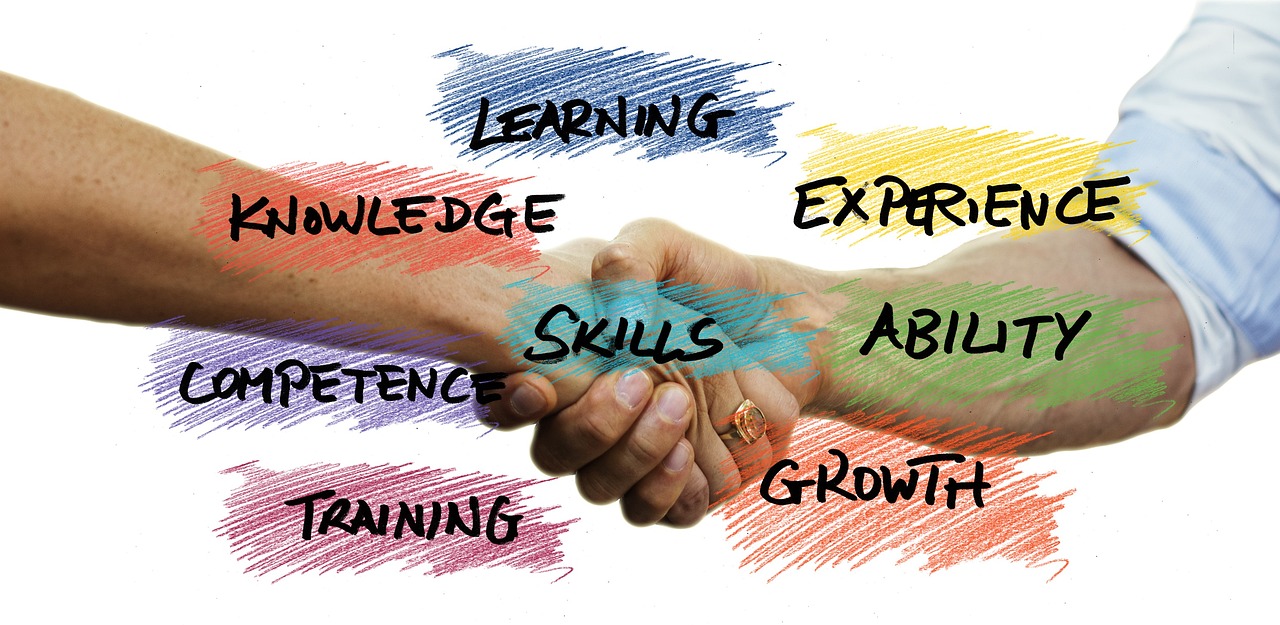
Military Simulations
When it comes to military training, the stakes are incredibly high. Soldiers must be prepared for a variety of scenarios, often under intense pressure. This is where Virtual Reality (VR) technology shines, revolutionizing the way military simulations are conducted. Imagine stepping into a fully immersive environment where you can engage in combat scenarios without the real-world risks. VR allows for this kind of training, providing soldiers with the opportunity to hone their skills in a safe yet realistic setting.
One of the major advantages of VR in military training is the ability to replicate diverse environments and situations. Whether it's urban warfare, desert combat, or maritime operations, VR can create a myriad of scenarios that soldiers might face in the field. This not only prepares them for the unexpected but also enhances their decision-making skills under pressure. In fact, studies have shown that engaging in realistic simulations can improve a soldier's performance by up to 30% when they encounter similar situations in real life.
Furthermore, VR technology can facilitate team-based training. Soldiers can engage in missions together, enhancing their ability to work as a cohesive unit. The simulations can be designed to require communication, strategy, and collaboration, which are essential skills in actual combat situations. By participating in these realistic drills, soldiers can build trust and camaraderie with their teammates, essential components of a successful military operation.
Additionally, VR training offers a unique opportunity for after-action reviews. After completing a simulation, soldiers can review their performance in real-time, analyzing what went right and what could be improved. This immediate feedback loop is invaluable for refining tactics and strategies. The ability to review scenarios from multiple perspectives allows for a deeper understanding of both individual and team dynamics during training exercises.
The cost-effectiveness of VR training is another compelling reason for its adoption in military settings. Traditional training methods often involve significant expenses related to travel, equipment, and facilities. In contrast, VR simulations can be conducted in controlled environments, reducing the need for extensive logistical support. This not only saves money but also allows for more frequent training sessions, ensuring that soldiers remain sharp and ready for deployment.
As we look to the future, the potential for VR in military training is boundless. With advancements in technology, we can expect even more sophisticated simulations that incorporate artificial intelligence (AI) to adapt scenarios based on the individual soldier's performance. This level of personalization will enhance the training experience, making it more relevant and effective for each service member.
In conclusion, the integration of VR technology into military training represents a paradigm shift that enhances readiness and effectiveness. As soldiers train in these immersive environments, they gain the skills and confidence necessary to face real-world challenges. The future looks bright for military simulations, with ongoing innovations promising to take training to new heights.
- What are the primary benefits of using VR in military training?
VR offers safe, immersive environments for realistic training, enhancing skill acquisition, team collaboration, and decision-making under pressure. - How does VR training compare to traditional training methods?
VR training is more cost-effective and allows for repeated practice in diverse scenarios without the logistical challenges of traditional methods. - Can VR training be personalized for individual soldiers?
Yes, future advancements in VR technology will likely incorporate AI to create tailored training experiences based on individual performance. - Is VR training effective in improving soldier performance?
Research indicates that engaging in realistic VR simulations can improve performance by up to 30% in real-world situations.
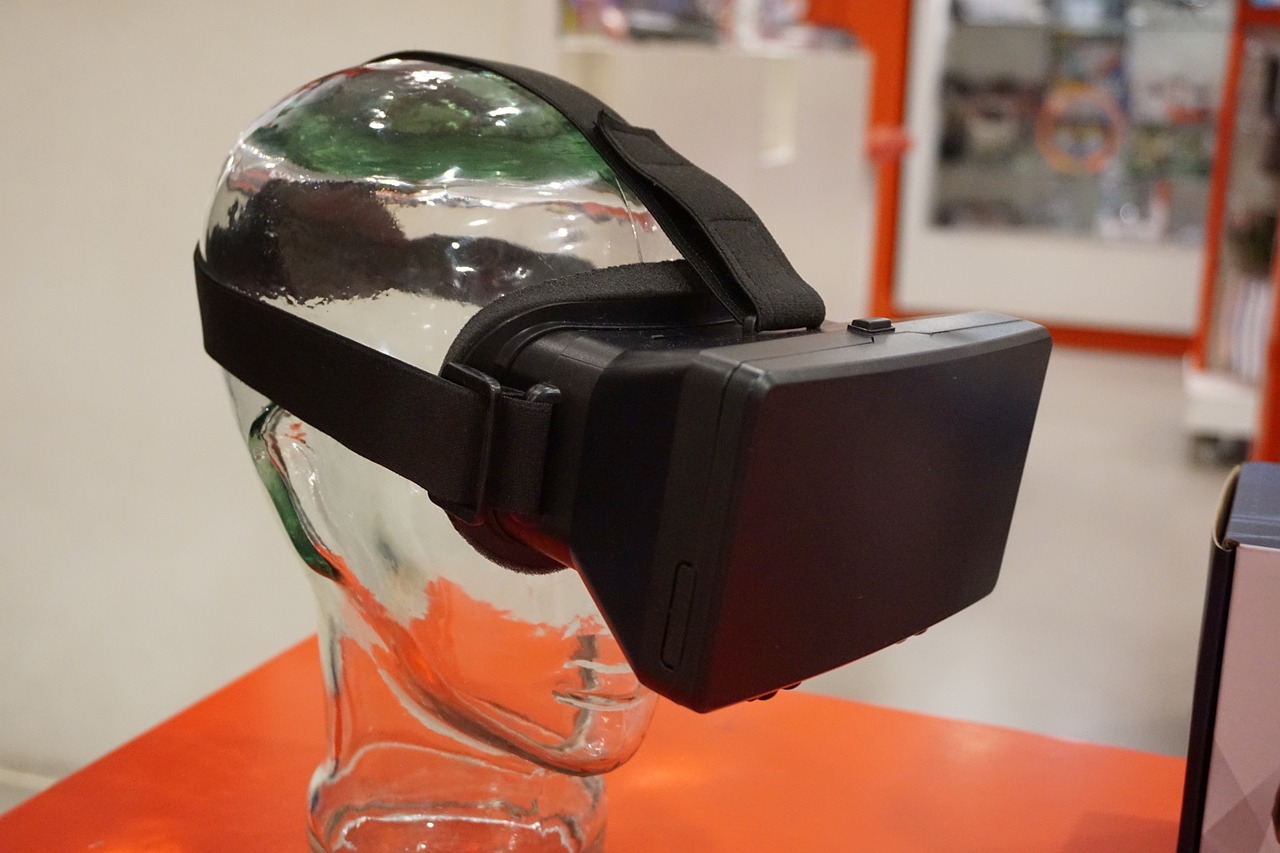
Future Trends in VR Training
As we look to the horizon, the future of Virtual Reality (VR) training is brimming with potential and innovation. The rapid advancements in technology are set to revolutionize the way we approach learning and skill development. One of the most exciting trends on the cusp of becoming mainstream is the integration of artificial intelligence (AI) with VR systems. Imagine a training program that not only immerses you in a virtual environment but also adapts in real-time to your unique learning style and pace. This fusion of VR and AI will allow for a more tailored experience, ensuring that each learner receives personalized guidance, feedback, and challenges that align with their individual progress.
Moreover, as VR technology continues to evolve, we can anticipate a significant push towards expanding accessibility. Currently, many VR training programs require expensive equipment and software, which can limit their reach. However, future developments are likely to focus on creating more affordable and user-friendly VR solutions. This democratization of technology means that individuals from diverse backgrounds—whether in remote areas or underserved communities—will have the opportunity to engage with immersive learning experiences. The goal is to make VR training not just a luxury for a few but a viable option for many, thereby fostering a more inclusive educational landscape.
In addition to AI integration and enhanced accessibility, we can expect VR training to incorporate multi-user environments. These environments will allow learners to interact with peers and instructors in real-time, creating a collaborative atmosphere that mirrors real-world situations. This social aspect of learning is crucial, as it encourages teamwork, communication, and problem-solving skills, all of which are essential in today’s workforce. Picture a group of medical students practicing surgical techniques together in a virtual operating room; the ability to collaborate and receive feedback from peers and mentors can significantly enhance the learning experience.
Furthermore, the future of VR training will likely see the emergence of hybrid training models that combine traditional methods with virtual experiences. While VR offers unparalleled immersion, certain skills still benefit from hands-on practice. By blending in-person training with VR simulations, organizations can create comprehensive programs that maximize the strengths of both approaches. For instance, a corporate training program might include VR modules for scenario-based learning, followed by real-world applications to solidify the skills acquired.
Lastly, the continuous development of content creation tools for VR will empower organizations to design their own training modules tailored to their specific needs. As these tools become more intuitive and accessible, companies will be able to craft immersive experiences that reflect their unique challenges and objectives. This ability to customize VR training will not only enhance engagement but also ensure that learners are adequately prepared for the specific demands of their roles.
- What is VR training?
VR training uses virtual reality technology to create immersive learning experiences that simulate real-world scenarios.
- How does AI enhance VR training?
AI personalizes the training experience by adapting to individual learning styles and providing real-time feedback.
- Is VR training accessible to everyone?
Future trends aim to make VR training more affordable and accessible to a wider audience.
- Can VR training be used in multiple industries?
Yes, VR training is applicable in various sectors, including healthcare, military, aviation, and corporate training.

Integration with AI
The integration of artificial intelligence (AI) with virtual reality (VR) is not just a trend; it's a revolution in the way we approach training and learning experiences. Imagine stepping into a virtual world where the environment adapts to your learning pace and style, providing tailored challenges that enhance your skills. This is the future that AI and VR are creating together. By leveraging AI algorithms, VR training programs can analyze user interactions and adjust scenarios in real-time, ensuring that every learner receives a personalized experience that caters to their specific needs.
For instance, in a VR training simulation for medical professionals, AI can track a trainee's actions and provide immediate feedback on their technique. If a user struggles with a particular procedure, the AI can modify the scenario to focus on that skill, offering additional practice until proficiency is achieved. This level of customization not only boosts the learner's confidence but also significantly improves the retention of complex information.
Moreover, the power of AI can extend beyond just feedback. It can also predict potential challenges a learner might face based on their performance history. By analyzing data such as response times, decision-making patterns, and even emotional reactions, AI can suggest tailored learning paths. For example, if a user consistently hesitates in high-pressure situations, the AI could create simulations that gradually increase in difficulty, helping them build resilience and improve their reaction time.
As we look to the future, the possibilities become even more exciting. The combination of VR and AI can lead to the development of intelligent virtual tutors that guide users through their training journey. These tutors could provide support, answer questions, and even simulate peer interactions, creating a more holistic learning environment. Just picture a scenario where learners can practice soft skills such as negotiation or teamwork in a safe, virtual space, receiving real-time coaching from an AI mentor.
In summary, the integration of AI into VR training not only enhances the learning experience but also prepares individuals for real-world challenges more effectively. This synergy is paving the way for a new era of training programs that are not only immersive but also intelligent and adaptable, ensuring that learners are always equipped with the skills they need to succeed.
- What is the main benefit of integrating AI with VR?
Integrating AI with VR allows for personalized training experiences that adapt to individual learning styles and needs, enhancing skill acquisition and retention. - Can AI provide real-time feedback in VR training?
Yes, AI can analyze user performance in real-time and offer immediate feedback, helping learners correct mistakes and improve their techniques on the spot. - How does AI predict learner challenges?
AI uses data from previous interactions to identify patterns and predict areas where a learner may struggle, allowing for tailored training scenarios that focus on those challenges. - Will AI replace human trainers in VR?
While AI can enhance training experiences, it is not meant to replace human trainers but rather to complement their efforts by providing additional support and personalized learning paths.

Expanding Accessibility
As we look to the future of VR training, one of the most exciting prospects is the expansion of accessibility. The goal is to ensure that immersive learning experiences are available to everyone, regardless of their background, location, or financial resources. Imagine a world where a student in a remote village can access the same high-quality training as someone in a bustling city. This is not just a dream; it’s becoming a reality as VR technology evolves.
One of the key factors in expanding accessibility is the reduction of costs associated with VR equipment and software. As technology advances, we are witnessing a decrease in the prices of VR headsets and related devices. This trend is making it feasible for educational institutions and organizations to invest in VR training programs without breaking the bank. Furthermore, with the introduction of mobile VR platforms, users can experience immersive training without the need for expensive setups. This opens the door for more people to participate in VR training, regardless of their financial situation.
Additionally, the development of cloud-based VR solutions is another game-changer. These platforms allow users to access VR training modules from any device with an internet connection. Imagine being able to log into a virtual classroom from your phone or tablet and engage in a fully immersive training session! This accessibility means that even those in underprivileged areas can benefit from cutting-edge training methods.
Moreover, the integration of multilingual support in VR training programs is crucial for expanding accessibility. By offering training content in multiple languages, we can cater to a more diverse audience, ensuring that language barriers do not hinder learning. This inclusivity not only enhances understanding but also fosters a sense of belonging among learners from various cultural backgrounds.
To further illustrate the impact of expanding accessibility in VR training, consider the following table that highlights key factors:
| Factor | Impact on Accessibility |
|---|---|
| Cost Reduction | More institutions can afford VR technology, reaching a wider audience. |
| Mobile Platforms | Access to training from various devices, breaking geographical barriers. |
| Cloud Solutions | Flexible access to training materials anytime, anywhere. |
| Multilingual Support | Inclusive training for non-native speakers, enhancing understanding. |
In essence, the future of VR training is not just about advanced technology; it’s about ensuring that this technology is accessible to all. By focusing on reducing costs, leveraging mobile and cloud solutions, and promoting inclusivity through multilingual support, we can create an environment where everyone has the opportunity to learn and grow. This vision of accessibility is what will truly transform the landscape of training and education, making it more equitable and effective for all.
- What is VR training? VR training uses virtual reality technology to create immersive learning experiences.
- How can VR training be made accessible? By reducing costs, utilizing mobile platforms, and offering multilingual content.
- What industries benefit from VR training? Industries such as healthcare, military, aviation, and corporate training are leveraging VR technology.
- What are the future trends in VR training? Future trends include the integration of AI and expanding accessibility to diverse populations.
Frequently Asked Questions
- What is virtual reality (VR) technology?
Virtual reality (VR) technology is an immersive digital experience that simulates a realistic environment, allowing users to interact with 3D worlds through specialized hardware like headsets and motion controllers. It creates a sense of presence, making users feel as though they are part of the virtual environment.
- How does VR enhance training outcomes?
VR enhances training outcomes by providing engaging and immersive experiences that improve retention and skill acquisition. Learners can practice in realistic scenarios, receive real-time feedback, and explore complex situations without the risks associated with real-life training.
- What are the main benefits of using VR for training?
The main benefits of using VR for training include:
- Enhanced Engagement: Users are captivated and focused, leading to better learning.
- Safe Simulations: Trainees can practice high-stakes scenarios without real-world consequences.
- Cost-Effectiveness: Reduces expenses related to travel and physical training setups.
- In which industries is VR training being applied?
VR training is being applied across various industries, including:
- Healthcare: Medical professionals practice procedures in a risk-free environment.
- Military: Soldiers experience combat scenarios safely.
- Aviation: Pilots train in flight simulators for various situations.
- Corporate Training: Employees undergo simulations for skill development and onboarding.
- What future trends can we expect in VR training?
Future trends in VR training include:
- Integration with AI: Personalized training experiences that adapt to individual learning styles.
- Expanding Accessibility: Making VR training available to a wider audience, regardless of background.
- Is VR training suitable for everyone?
While VR training offers numerous advantages, its suitability may vary based on individual preferences and comfort levels with technology. However, ongoing advancements aim to make VR more user-friendly and accessible to diverse learners.


